Dec. 22, 2017
Portions of the Lake Apopka Wildlife Drive reopened within the District’s Lake Apopka North Shore property. The wildlife drive, like many other trails on the property, required repairs after experiencing damage due to Hurricane Irma in September 2017. After water levels receded, the District filled potholes and regraded roads that had been saturated by the storm. Several roads remained closed due to damage sustained in the hurricane.
Dec. 19, 2017
A sump dredge project — designed to help improve water quality at Lake Apopka — began. The project is unique from previous dredging projects because it will create a sump, or a depression, at the lake-bottom to collect nutrient-laden sediment near the mouth of the Apopka-Beauclair Canal. Collecting and eventually removing the material is expected to reduce turbidity in Lake Apopka and help improve water quality.
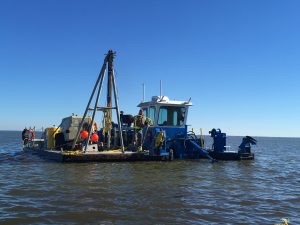
Dec. 12, 2017
The District’s Governing Board approved the ranking of projects to share in up to $3.5 million in cost-share funds to benefit water resources in Rural Economic Development Initiative (REDI) communities and for projects that use innovative technology to provide data supporting future permitting and full-scale implementation of alternative water supplies. The District received 17 project applications, all from REDI communities. Ten applications met program criteria; of those, seven projects were selected to receive funding.
Dec. 7, 2017
The District joined the Southwest Florida Water Management District in encouraging homeowners in its 18-county region to “Skip a Week” of lawn and landscape irrigation during the cooler months of December, January and February. Studies show that skipping a week of irrigation when your yard doesn’t need it keeps lawns healthy and helps to conserve drinking water supplies. Skipping irrigation every other week was anticipated to save more than 1 billion gallons of water.
Dec. 4, 2017
Fishermen netted 100,000 pounds of nutrient-laden gizzard shad from Lake Apopka in one week under a project funded by the District as part of a multifaceted approach to restoring water quality. The District expected that 1 million pounds of undesirable fish, mostly gizzard shad, along with some tilapia, gar and invasive armored catfish, would be harvested during the season, removing about 8,000 pounds of phosphorus.
Dec. 1, 2017
The District, working with the Florida Department of Environmental Protection (DEP), announced a new funding program targeting the removal of septic tanks in the Volusia Blue, Wekiwa and Silver springsheds, replacing them with individual distributed wastewater treatment systems in areas where sewer line extensions may not exist or be financially feasible. DEP provided $1 million to match a contribution of $500,000 from the District and $500,000 from local governments or utilities.
Nov. 28, 2017
An easement on three acres of county-owned property on Black Creek was approved by the Clay County Board of County Commissioners (BOCC) to implement the Black Creek Water Resource Development Project (WRD), a key component to meeting northeast Florida’s water supply needs. The easement also allows for the construction of a kayak/canoe launch and connected parking for future public access to Black Creek. The BOCC unanimously approved granting a perpetual easement to the District over the county’s property near the intersection of state roads 16 and 21, encompassing a portion of Black Creek.
Nov. 14, 2017
Twelve agricultural projects were selected to share in $1.5 million from the District to improve water conservation and reduce nutrient loading to area waterways. The District’s Governing Board approved the project ranking at its Nov. 14 meeting. Once implemented, the projects were anticipated to collectively conserve an estimated 519 million gallons of water each year and reduce total nitrogen by an estimated 52,945 pounds per year and total phosphorus by 8,149 pounds per year. The District received 30 applications seeking funds through the Fiscal Year 2017-2018 Districtwide Ag Cost-share Program for projects in the 15 counties outside the Tri-County Agricultural Area (portions of Flagler, Putnam and St. Johns counties.
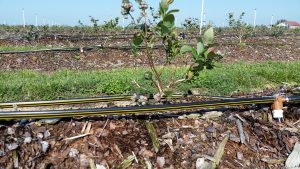
Agricultural cost share funded a micro-drip irrigation conversion project at a blueberry farm.
Oct. 11, 2017
Eleven schools received grant funding from the District’s Blue School Grant Program for projects to enhance student development in science, technology, engineering and math (STEM) related topics. More than two dozen teachers applied for funding in 2017 and of them the top 11 projects were selected. The program offered $20,000 in financial support to middle and high school teachers working to promote water resource protection through hands-on learning opportunities. Projects included water quality improvement field studies, water conservation garden projects, classroom/community awareness and freshwater resources educational programs.
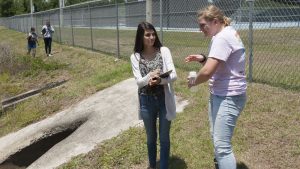
Oct. 10, 2017
At its October governing board meeting, District staff reported that Hurricane Irma brought 2.2 trillion gallons of rainwater, or enough to cover 6.7 million football fields in one foot of water, to the District’s 18-county service area over a two-day period. Hurricane Irma brought excessive rainfall and spanned the entire District, and because it followed a period of heavy rain. Districtwide, the average rainfall resulting from Hurricane Irma was 10.24 inches.
Sept. 26, 2017
The District’s Governing Board voted to rescind the Districtwide Water Shortage Warning Order following an extended period of increased rainfall. The Water Shortage Warning Order was originally issued in March 2017 due to below-average rainfall and declining hydrogeologic conditions. The purpose of the order was to increase awareness for the need to conserve water during drought conditions and ensure sufficient water was available to meet the needs of people and the environment.The District’s Governing Board adopted its fiscal year 2017–2018 budget, which provides funds for cost-share projects and major programs to support the agency’s core missions of water supply, water quality, natural systems and flood protection. The board also approved reducing the millage rate for taxpayers for a fifth year. The budget supports cooperative funding projects and water resource protection programs that directly benefit the environment, local communities and the economy.
Sept. 19, 2017
The District’s Governing Board voted to rescind the Districtwide Water Shortage Warning Order following an extended period of increased rainfall. The Water Shortage Warning Order was originally issued in March 2017 due to below-average rainfall and declining hydrogeologic conditions. The purpose of the order was to increase awareness for the need to conserve water during drought conditions and ensure sufficient water was available to meet the needs of people and the environment.
Sept. 15, 2017
Days after Hurricane Irma’s storm surge had receded, the St. Johns River and other water bodies continued to rise in many areas, causing flooding headaches for local governments and their residents. The District continued to mitigate flooding impacts in support of local emergency operations as communities worked to recover and restore services. The District sent its public works staff and portable pumps and generators to areas flooded by the storm. Staff helped pump stormwater in Flagler County, St. Johns County, Putnam County, Seminole County and in Hawthorne.
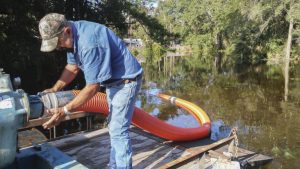
Sept. 11, 2017
Massive Hurricane Irma brought dramatic flooding across Florida, from the Keys all the way to the St. Johns River in Jacksonville. On Sept. 10, the District began diverting water from the Upper St. Johns River Basin Project to reduce floodwaters flowing north, providing flood protection for people and property downstream, particularly in hard-hit Jacksonville. To increase water storage capacity in the Upper St. Johns River Basin in advance of the storm, the District had opened flood-control structures in the Upper St. Johns River Basin Project.
Sept. 5, 2017
The District began making preparations for Hurricane Irma, opening flood-control structures in the Upper Ocklawaha River Basin to create additional capacity. Structures were opened at the Nutrient Reduction Facility near the Apopka-Beauclair Lock and Dam and the Burrell Dam, as well as the Harris Bayou and Apopka Dam. The Moss Bluff Dam was opened a few days later.
Aug. 16, 2017
The District launched a new and improved website featuring a more contemporary look, streamlined pages and improved navigability. In addition to its improved appearance, the website was built in a responsive format, which allows it to correctly and instantly resize to fit and function on mobile devices as well as desktop computers. The website also featured expanded search features, updated information on hundreds of webpages, and a streamlined menu that provided more user-friendly categories and pages redesigned to improve navigation.
Aug. 15, 2017
The District was awarded the Distinguished Budget Presentation Award for its fiscal year 2016-2017 budget from the Government Finance Officers Association of the United States and Canada. Mary-Lou Pickles, director of the District’s Office of Financial Services and the District’s former budget director, also was recognized.

Aug. 8, 2017
The District was awarded the Certificate of Achievement for Excellence in Financial Reporting for its fiscal year 2015–2016 Comprehensive Annual Financial Report from the Government Finance Officers Association of the United States and Canada. District Finance Director Greg Rockwell also was recognized.
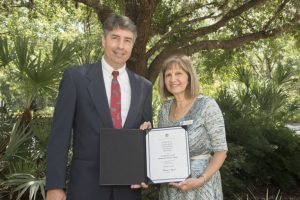
Aug. 3, 2017
The District began accepting applications for the second year of its Blue School Grant Program, offering up to a total of $20,000 for teachers working to promote water resource protection through hands-on learning opportunities. Grants of up to $2,000 per teacher per school could be used in four areas: water quality field study, water conservation garden project, classroom/community awareness, and freshwater resources educational program.
July 11, 2017
A project to provide recharge to the Floridan aquifer using excess water from flood-prone Black Creek received a nod from the District’s Governing Board, which directed its executive director to negotiate with the top-ranked design/engineering firm to get the project off the ground. Funding for the project comes from a 2017 legislative appropriation championed by Sen. Rob Bradley and Rep. Bobby Payne and will be administered by the District. The Black Creek project is one of several projects identified in the North Florida Regional Water Supply Plan to help meet future water supply demands while protecting natural resources. This project, which will be built in southwest Clay County between Penney Farms and Camp Blanding, focuses on providing recharge to the Upper Floridan aquifer in the Keystone Heights region and Lower Santa Fe basin.
June 26-27, 2017
Lightning sparked wildfires along Interstate 95 on the District’s Three Forks Marsh Conservation Area, burning more than 2,000 acres over two days. Dry spring conditions resulted in several wildfires on District lands during the summer, but no serious injuries were reported to staff fighting those fires, nor was there any damage to private property.
June 7, 2017
Gov. Rick Scott appointed Janet Price of Fernandina Beach to the District Governing Board, filling a vacant seat that represents the St. Marys River Basin and the adjacent coastal area. The appointment takes effect immediately and runs through March 1, 2018. Price is the corporate environmental manager for Rayonier, Inc.

May 23, 2017
Florida Water Star presented six awards to local organizations and individuals for their work to further water conservation. Developed by the District and launched in 2007, the Florida Water Star program provides water conservation certification for homes, entire communities and commercial developments. Six awards recognized a variety of achievements in water conservation across Florida.
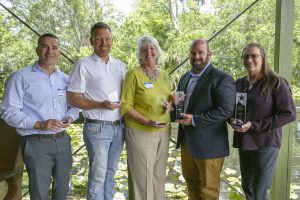
May 11, 2017
The District staff and partners celebrated the completion of improvements along a mile-long stretch of the C-1 Canal in Palm Bay. Newly contoured banks along a mile stretch of the canal allow the Melbourne-Tillman Water Control District to maximize flows west to the St. Johns River instead of east to the Indian River Lagoon. For decades, the C-1 Canal shunted stormwater east to the lagoon. Recent improvements complement an original project by maximizing the return of flow westward to the St. Johns River, instead of allowing it to flow unimpeded eastward to Turkey Creek and the Indian River Lagoon.
May 9, 2017
The District’s Governing Board approved an agreement that cleared up a 45-year-old title issue and create a continuous greenway corridor that includes the Silver Springs Bikeway. The seven-acre Sigler property adjacent to the Ocklawaha Prairie Restoration Area in Marion County, was originally part of a federal flood control project in 1972. The property changed hands from the federal government to the Southwest Florida Water Management District in 1976, then to the St. Johns District in 1977. However, property records did not show the change of ownership.
May 4, 2017
The District began dye testing at the east end of the C-54 canal to evaluate subsurface water flows in Brevard-Indian River County near the S-157 water control structure. Dye testing aids District staff in determining underground water flows. The dye, bright-green in color, is harmless but can linger in the water for several days following testing.
April 25, 2017
More than 130,000 visitors experienced the District’s one-way, 11-mile Lake Apopka Wildlife Drive in its first two years. The drive traverses a network of wetlands, levees and canals, providing a variety of wildlife viewing opportunities. To commemorate the second anniversary, volunteers with the Orange Audubon Society were stationed along the drive with scopes, bird books and loaner binoculars to assist visitors with identifying wildlife.
April 11, 2017
The District’s Governing Board approved completing the rulemaking process to set minimum flows and levels for Silver Springs in Marion County, defining a protective limit on the amount of available water beyond which further groundwater withdrawals would be significantly harmful to Silver Springs.
Florida Statutes require the adoption of minimum flows and levels for Silver Springs and other Outstanding Florida Springs by July 1, 2017.
April 4, 2017
The number of certifications being sought through the Florida Water Star program for water conservation increased 200 percent in 2016. In its first 10 years, 4,100 residences received water conservation certification through the program. The number of certifications being sought increased from 79 homes in 2015 to 283 homes in 2016.
March 31, 2017
Gov. Rick Scott appointed Susan Dolan of Sanford to the District’s Governing Board and reappointed Douglas Burnett of St. Augustine. Dolan is the director of community affairs for Waste Pro of Florida, Inc., and Burnett is the president of Doug Burnett and Associates, LLC.
March 30, 2017
Putnam County Schools, the city of Bunnell and the town of Pomona Park benefitted from thousands of dollars of surplus items from the District. These Rural Economic Development Initiative community partners were notified that they will receive a variety of computer monitors, PCs and vehicles from the District’s program to donate surplus equipment to economically disadvantaged communities. The District routinely disposes of items that are obsolete, serve no useful function, are uneconomical or inefficient for continued use, or have exceeded their useful service life.
March 15, 2017
The District Governing Board approved the ranking of projects that will share in $1.5 million in Tri-County Agricultural Area Ag Cost-Share funding for water conservation and nutrient reduction by ag operations. The District received 13 applications as part of the Districtwide Ag Cost-share Program for projects in Flagler, Putnam and St. Johns counties. the Fiscal Year 2016-2017 TCAA Cost-Share Program.
March 8, 2017
43-year-old office building on University Boulevard North in Jacksonville received an energy and water makeover to receive the first-ever Florida Water Star certification for existing commercial buildings within the St. Johns District. District staff issued the certification this week to Custom Builders, which overhauled the seven-story office building to significantly reduce water use. The new owners of the 900 Building focused on three main areas to reduce water use. Outdoors, the irrigation system is no longer being used and the existing, well-established plants and trees sustain on rainfall alone. Indoors, the bathrooms were updated with high-efficiency toilets, urinals and faucets. In addition, they upgraded the HVAC/air conditioning system to use a lower quality water source.
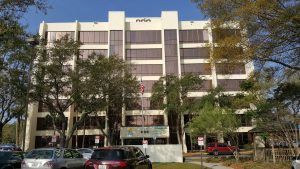
Feb. 23, 2017
Visitors and outdoor enthusiasts gained a new way to explore the Lake Apopka North Shore with the official opening of a new recreational facilities at Lake Apopka North Shore. Representatives from several community organizations and governments joined the District for an event at McDonald Canal. Development of the new facilities started in 2015 with dredging of the McDonald and Apopka-Beauclair canals for a total project cost of $1.26 million.
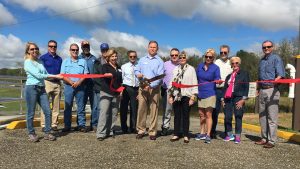
Feb. 16, 2017
The District, Florida Department of Environmental Protection, state and local elected officials, and Indian River Lagoon protection advocates celebrated the commencement of muck dredging from the Eau Gallie River at Ballard Park in Melbourne. “This project exemplifies the progress possible in improving conditions in the Indian River Lagoon through partnerships,” St. Johns River Water Management District Executive Director Dr. Ann Shortelle said during a kick-off ceremony.
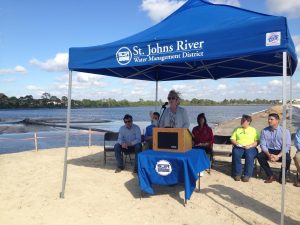
Feb. 1, 2017
Manatee protection received a boost when new water resource protection rules for Ponce de Leon Springs, set by the District, become effective. In mid-December 2016, the District’s Governing Board approved rule amendments to adopt minimum flows for the spring in Volusia County. The greatest benefit of this MFL on an Outstanding Florida Spring is the protection it provides to manatees in the winter by maintaining warm-water flows (71 to 74 degrees) from the spring to Spring Garden Run, aiding in the continued recovery of this endangered species.
Jan. 17, 2017
The governing boards of the St. Johns River and Suwannee River water management districts jointly approved a 20-year plan to protect the sustainability of water supplies and identify potential future water supply sources. Approval of the North Florida Regional Water Supply Plan completes a four-year public process and the first-ever joint planning effort between the two agencies and the Florida Department of Environmental Protection. The approved plan is a result of collaboration between a multitude of stakeholders from a variety of groups, organizations and entities from both water management districts that have an interest in the region’s water supply, including agriculture, commercial/power generation, environmental advocates, industrial/mining, local governments and public water suppliers.

